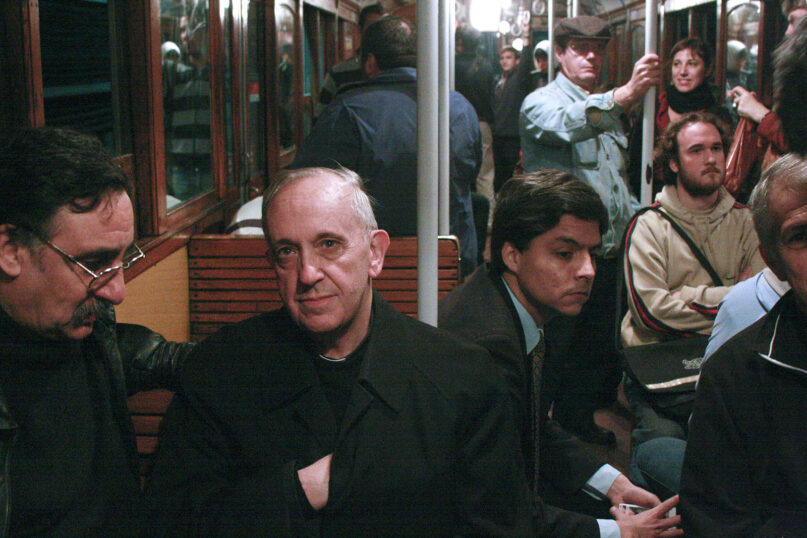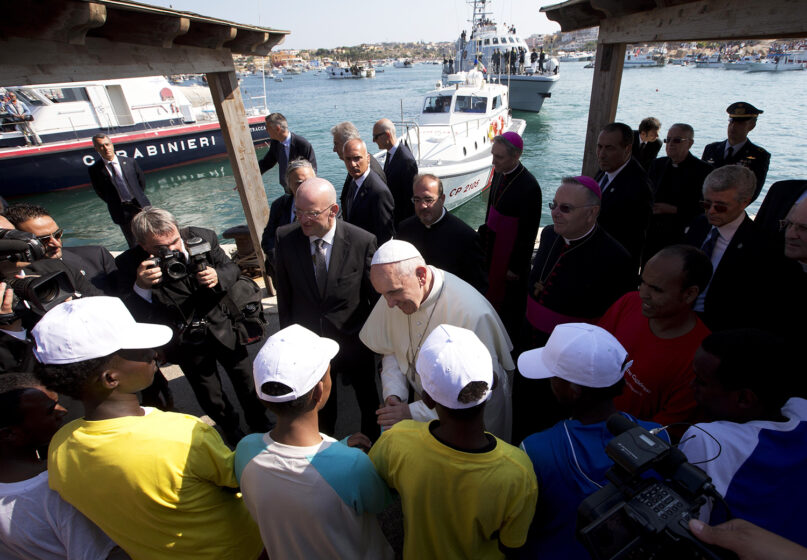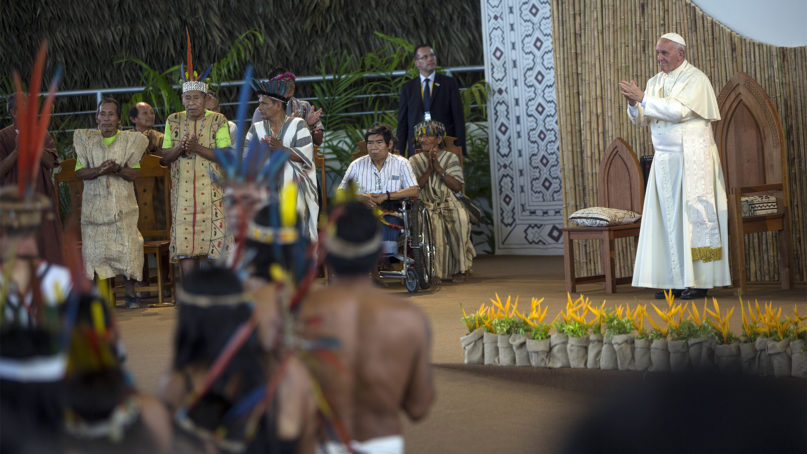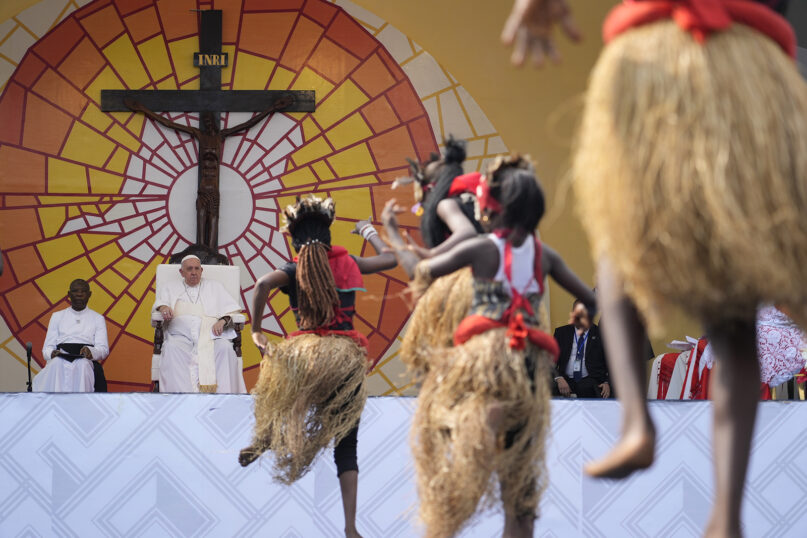(RNS) — When Pope Francis stepped onto the balcony of St. Peter’s Basilica for the first time back in 2013, he told the crowds below him that the College of Cardinals had gone “almost to the ends of the earth” to find the new bishop of Rome.
Over 500 years after papal bulls authorized the violent, colonial conquest of non-Christian peoples, paving the way for Catholicism to take root in the Americas, Francis was the first pope to emerge from those lands. Drawing on the region’s theology that emphasizes collaboration and developed in response to continued struggles with colonialism, Francis pushed for a Catholic Church with broader participation and inclusion of people on the margins, scholars told RNS before and after his death on Monday (April 21).
“We were, for several centuries, a church that reflected what they do in Europe — we repeated, copied Europe,” said Maria Clara Lucchetti Bingemer, a theology professor at the Pontifical Catholic University of Rio de Janeiro, in Spanish.
Latin American bishops began to implement the teachings of the modernizing Second Vatican Council right after the council in the early 1960s. And as a result, “we try to be a church that is a source, a church that generates its own content, that generates the way we celebrate our rituals, that generates our priorities,” Bingemer said. Francis made sure those efforts grew “in a strong and exponential way.”
As archbishop of Argentina, Cardinal Jorge Bergoglio, who would take the name Francis when he became pope in 2013, came up within the Latin American bishops’ conference, known as CELAM. That school of thought would become prominent during his papacy.
In 2007, he chaired the committee that drafted the final document for CELAM’s general conference in Aparecida, Brazil, which encouraged Catholics to be “missionary disciples” and described the church as the “home of the poor.” Both became key concepts six years later in Francis’ first apostolic exhortation, “Evangelii Gaudium,” in which the new pope encouraged the church to “go forth,” share “the joy of the Gospel” and understand “God’s heart has a special place for the poor.”

FILE – Cardinal Jorge Mario Bergoglio, second from left, travels on the subway in Buenos Aires, Argentina, in 2008. (AP Photo/Pablo Leguizamon, File)
Once Francis directed his theology to the world, Bingemer, who previously witnessed his firm leadership in Aparecida, said one could still “feel the presence of Latin American theology, the Latin American reception of the Second Vatican Council.”
While Francis might have shied away from labeling his influences as “liberation theology” — which Pope Benedict XVI once accused of uncritically borrowing Marxist influences — Bingemer said Francis’ theological lineage was clearly linked back to it, placing a heavy emphasis on the “preferential option for the poor.”
Reflecting the impact of migration experiences on Latin America, Francis emphasized the dignity of migrants throughout his papacy. He visited the island of Lampedusa in the Mediterranean Sea, a point of arrival for refugees and asylum-seekers, as his first trip outside of Rome. The new pope also celebrated Mass on an altar made of a painted boat, and he mourned “globalized indifference” and the migrants neglected by the world.
The Rev. Gustavo Morello, an Argentine Jesuit sociology professor at Boston College, said Francis’ papal policy was clearly marked by Argentine politics.
“ A key to understand Francis’ policy has been not progressive/conservative, not that distinction, but the distinction between peoples against elites,” a common tension within various ideological camps in Argentina, Morello said.

Pope Francis speaks to migrants, wearing white caps, during his visit to the island of Lampedusa, southern Italy, July 8, 2013. (AP Photo/Alessandra Tarantino, File)
Francis, known for his pastoral emphasis, focused on the people in front of him, Morello said, sometimes changing his mind when he saw people react against his decisions.
For example, after facing backlash when he dismissed accusations that Chilean leaders participated in covering up sexual abuse, Francis invited Chilean abuse survivors to the Vatican to ask for their forgiveness and to listen to them.
As CELAM is also known for its open-ended discussions and collaborations, Latin American church leaders immediately recognized their theological tradition on display when Francis announced a new synod format in 2021 that would begin with widespread consultation of the faithful and conclude with assemblies that included laypeople and women alongside bishops. The listening and accompaniment in the process were termed “synodality” and became a key concept in the modern church.
“The notion of synodality is really taken to heart as listening first and putting aside one’s own agenda,” said Neomi De Anda, executive director of the International Marian Research Institute at the University of Dayton in Ohio. “Really listening to one another is a notion of decolonization because that decenters everyone and centers the act and the possibility of listening.”

Pope Francis meets with Indigenous representatives in Puerto Maldonado, Peru, on Jan. 19, 2018. Standing with thousands of Indigenous Peruvians, Francis declared the Amazon the “heart of the church” and called for a three-fold defense of its life, land and cultures. (AP Photo/Rodrigo Abd)
De Anda, who has published research on decolonization, said that despite Francis’ efforts to apologize to Indigenous people for the church’s harm, “there’s still work to be done.”
“ There are big questions when it comes to decolonization and Christianity in general — about a religion that came from a colonizing perspective,” De Anda said. “And so, ‘how far can that be taken?’ I think is a fundamental question.”
Francis spoke forcefully against continuing colonialism, including about its impact on the environment and global conflicts.
Sister Ana María Siufi, a Sister of Mercy of the Americas, said Francis continuously denounced new colonization. He specifically focused on regions, including in Asia, Africa and Latin America, that had been heavily colonized and victims of “plundering, exploitation and domination by external debt,” she said in Spanish.
The pope’s environmental justice focus influenced Siufi in her own ministry in rural Argentine Patagonia that includes peasant and Indigenous Mapuche families. “Laudato Si’,” his environmental encyclical, “will continue to be one of the most extraordinary documents in the social and environmental doctrine” of the church, she said.
And for many Latin Americans and U.S. Latinos, Francis’ papacy allowed them to see their own faith traditions and culture take the highest stage in the church. His deep devotion to Mary, even asking to break tradition to be buried in the Basilica of St. Mary Major, and his fandom for his hometown soccer club remained familiar signs of where he came from.

Pope Francis approaches priests with an Argentine flag as he arrives in Saint Peter’s Square for his inaugural Mass at the Vatican on March 19, 2013. (Photo by Stefano Rellandini/Reuters)
But while he gained many fans and some prominent enemies becoming “the most relevant Argentinian figure in the 21st century,” Morello said inertia prevented Francis from recruiting more practicing Catholics in Latin America, where large majorities support at least some changes in the church’s teachings on gender and sexuality that Francis declined to back.
Francis’ 2013 election was a nod to the fact that in 2010, Pew Research Center found that 39% of Catholics worldwide came from Latin America and the Caribbean, far outstripping the 24% of Catholics from Europe — the home continent of the most previous popes — representing a century-long shift of the church toward the Global South.
And shortly before his death, Vatican statistics confirmed that a majority of the world’s Catholics are now in Latin America and Africa, with 41% of global Catholics in Central and South America. The share of global Catholics in Africa rose to 20% in 2025, from 16% in 2010.
Africans have also been impacted by the Francis papacy, said the Rev. Agbonkhianmeghe Orobator, who is from Nigeria and is dean of the Jesuit School of Theology of Santa Clara University in Berkeley, California, recalling the tremendous excitement in Kenya when Francis was elected.
“I saw Pope Francis’ Jesuit identity in the attention he paid to vulnerable people at the margins and the peripheries of the church and of society,” said Orobator, a delegate for Francis’ Synod on Synodality.

Pope Francis, second from left, watches traditional dancers perform at the Martyrs’ Stadium in Kinshasa, Democratic Republic of the Congo, Thursday, Feb. 2, 2023. Francis was in Congo and South Sudan for a six-day trip, hoping to bring comfort and encouragement to two countries that have been riven by poverty, conflicts and what he called a “colonialist mentality” that has exploited Africa for centuries. (AP Photo/Gregorio Borgia)
Catholics of all ideological backgrounds are now beginning to anticipate who might take the papacy next. Siufi said, “I think we all have fear — fear that this will cut short a process that we consider very healthy, this process of reform that must continue.”
The College of Cardinals determining the next pope now more closely reflects the global Catholic Church than the 2013 conclave. Today, 13% of cardinal-electors are from South America, 13% from Africa and 17% from Asia; less than half of cardinal-electors will be from Europe.
But regardless of what part of the global church he represents, the next pope should carry forward Francis’ humanity, Orobator said. Whether working to support the South Sudan peace process or arriving a half-hour early to synod sessions to bless, take selfies with and talk to delegates, “what stood out to me is his humanity, and his ability to connect with people in their situation, be it of joy or of pain,” Orobator said of Francis. “He focused on people.
“The Holy Spirit will inspire the cardinals during the conclave to elect a pope that the church and world need at this time,” he said.
